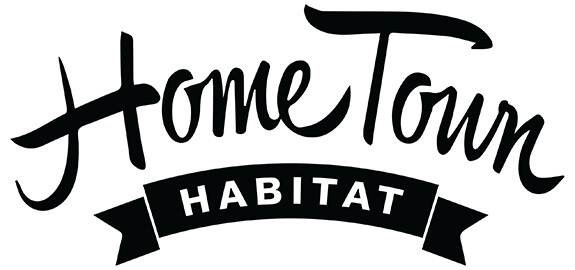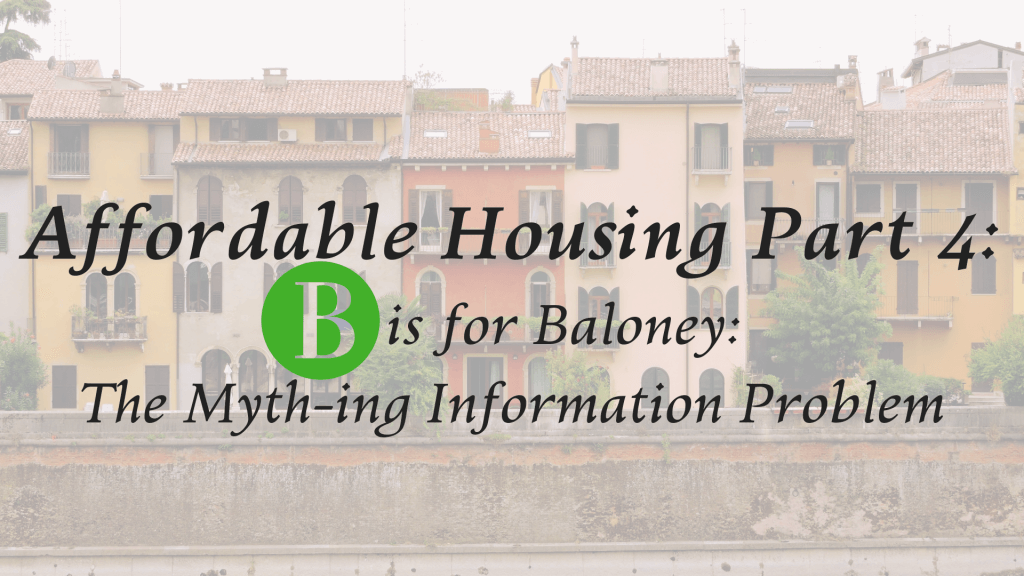Affordable Housing Part 4: B is for Baloney: The Myth-ing Information Problem
B is for Baloney: The Myth-ing Information Problem
What’s the first thing that pops into your mind when a young couple talks about finding affordable housing? What about when a politician talks about it? Or a non-profit?
Lots of myths and mis-information about affordable housing affect our understanding of it. Here are some of the highlights from a Community Housing Partners fact sheet, Affordable Housing Facts . (Similar sources are linked at the end of this article.)
- It’s ugly: In the past, this was probably true, but the laws have changed. Affordable housing has to fit the community character in size and style, and it has to meet the same building restrictions and design standards as market-rate housing. If government funding is involved, then construction might have even more restrictions or higher standards. What makes it ‘affordable’ is the financing of the construction and/or the mortgage.
- It increases crime: According the CHP fact sheet, “There is no correlation between safe, decent and affordable housing and crime. Studies show that what does cause crime (and a host of other socio-economic ills) is community disinvestment, overcrowding, and a lack of jobs and community services. Failure to build affordable housing leads to slum conditions of overcrowding, absentee owners and deteriorating properties with no alternatives available to low-income families…Careful screening, proper management, and security measures help assure that illegal activities do not take place and that, if they do, they are dealt with swiftly and decisively. Most affordable housing residents want nothing more than to become part of the quiet, peaceful life of the surrounding community. They have sought out affordable housing so that they can live independent, self-sufficient lives.”
- It isn’t an asset to the community: The opposite is true. Affordable housing “enables low-paid workers and others to avoid homelessness…avoid the need for public benefits…enables individuals to stabilize their lives so they can pursue jobs, access needed services, and deal effectively with any problems they may have…Availability of affordable housing enables the city to attract and to retain employers who require affordable housing for their lower level employees…also reduces the stress on other government-provided social services.”
Other sources note another common myth: “I don’t know anyone who needs affordable housing.” Actually, you probably know at least one and maybe even several. Let’s go back to the definition of ‘affordable,’ which is that no more than 30% of gross household income is spent on rent/utilities or, in the case of home ownership, PITI (principle, interest, taxes, and insurance).
Look at the chart below; if you’re earning $10 per hour, on a 40 hour week, a 4 week month, an affordable rent or mortgage situation would mean paying no more than $480 per month. This is at an annual income of $19,200. Another way to look at this is to look at the monthly rent column; for example, it’s very common to see a 2 bedroom apartment renting for $1200+ per month. To keep that ‘affordable’ you’d have to be earning $48,000 per year.
|
Hourly Wage |
Weekly gross income @ 40 hours | Income working 4 weeks per month | Affordable Monthly Housing Expense | Annual Income required: |
|
40 |
4 |
30% |
||
|
$8.25 |
$330 | $1,320 | $396 |
$15,840 |
|
$10.00 |
$400 |
$1,600 | $480 |
$19,200 |
|
$15.00 |
$600 | $2,400 | $720 |
$28,800 |
|
$25.00 |
$1,000 | $4,000 | $1,200 |
$48,000 |
| $30.00 | $1,200 | $4,800 | $1,440 |
$57,600 |
Any guesses as to a typical income in your company? Your church? Your community? Do you know what the median hourly wage is for your area? The median rent? Once we look at housing costs from the perspective of hourly or annual income, we learn a few things…and we’d be surprised at who we know or who we’re near who needs affordable housing options.
To better understand this way of looking at the issue, the National Low Income Housing Coalition (NLIHC) calculates what they call “The Housing Wage.” This number illustrates what hourly wage you’d have to earn to afford the typical rent based on where you live. For 2018, Florida has the 16th highest housing wage requirement in the entire country. Any guesses at to what you’d have to earn per hour to afford a typical 2 bedroom rental home in the state? Or if you’re earning minimum wage, how many hours you’d have to work each week to meet that ‘affordable’ number? I double dog dare you to find out!
 Your turn: If you’re up for the double-dog dare, go to the NLIHC site and see what hourly wage is required to afford (pay less than 30% of household income) rent/PITI in various locations. You can even drill down by zip code.
Your turn: If you’re up for the double-dog dare, go to the NLIHC site and see what hourly wage is required to afford (pay less than 30% of household income) rent/PITI in various locations. You can even drill down by zip code.
We encourage you to talk about this with everyone you know. Why? Because there’s someone out there who needs this information…and feel free to send them our way if they’re looking for an affordable home to buy in Lake or Sumter Counties. Let’s get the word out about making housing affordable!
And don’t forget to share your discoveries with us on social media.
Additional resources:
click here https://www.abodo.com/blog/heavy-housing-burden/
click here https://www.abodo.com/blog/renter-cost-burdens-by-generation/
click here http://www.shimberg.ufl.edu/publications/FL_2017_RMS_fact_sheet.pdf (Florida specific info)


